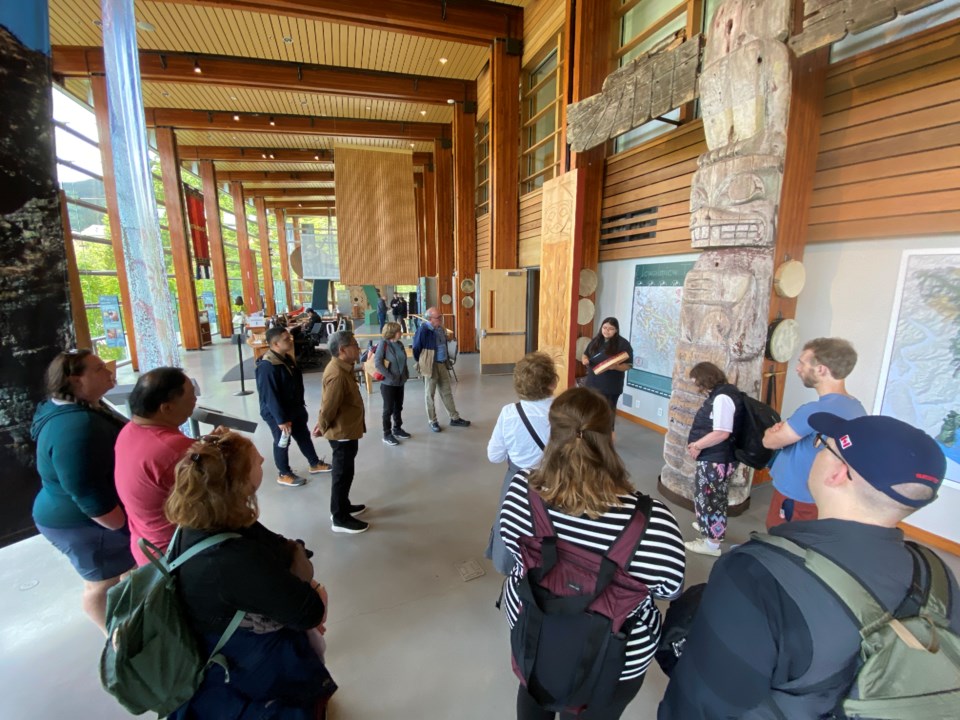Each year, about 3 million people fly, bus, and drive to Whistler to enjoy all the world-famous ski and bike resort has to offer.
For the most part, they come to explore the namesake mountains of Whistler Blackcomb, or live the après nightlife, but more and more, guests to Whistler are finding their way up Lorimer Road to the Squamish Lil’wat Cultural Centre (SLCC).
And once they arrive, they realize the First Nations museum/art gallery/meeting place is so much more than another compliment to tourism.
“It is my favourite thing. I absolutely adore this building,” says Téc tec (Delilah Peters), already a longtime SLCC ambassador at just 18 years old. Téc tec has worked at the SLCC for four years, but her connection to the centre stretches back to its construction.
“I’ve been coming here since it opened [in 2008], when I was like three,” she says. “So this is like home to me, and my dad [Bradley Peters] actually helped build this building.”
Designed by architect Alfred Waugh to resemble both the longhouses of the Squamish people and the Istken, or earthen pit houses, of the Lil’wat, the SLCC remains a modern marvel nearly two decades after it opened its doors.
Even on a random Friday in mid-June, the centre’s Great Hall is milling with a dozen or more guests, taking in the exhibits at their own pace before Téc tec gathers them for a traditional welcome song.
Today, guests are signing in from as far away as Belgium and the Netherlands, though it’s not at all uncommon to hear check-ins from even further afield.
“I absolutely love it, because I also hear stories from people, and their own experiences relating to what I’m talking about,” Téc tec says.
To call the SLCC Whistler’s best-kept secret isn’t entirely accurate—the centre has garnered international recognition since Day 1, and the influence of it and its ambassadors in Whistler has only grown in recent years, as evidenced by their being named Citizen of the Year at the Whistler Chamber of Commerce’s 2023 Whistler Excellence Awards—but if you somehow haven’t been yet, you’re missing out.
There’s no time like the present: Friday, June 21 is National Indigenous Peoples Day in Canada, and admission to the SLCC is free.
And if you haven’t been lately, a pair of new exhibits are well worth a repeat visit.
Ta na wa Yúus ta Stitúyntsam’ / skel7áw’lh (The person who protects the land / Steward of the land), on display until June 30, showcases how the Sk_wx_wú7mesh Úxwumixw and Líl’wat7úl have cared for their traditional territories since time immemorial.
Declaration of the Lillooet Tribes, meanwhile, shares the history of the Chiefs of 11 communities that came together to sign the famed declaration on May 10, 1911, and is on display until the end of the year.
There’s also a variety of workshops and tours on offer throughout the year (head to slcc.ca for more).
“I love working here,” Téc tec says. “My favourite thing is talking about my culture and getting to teach it to other people who don’t know it, and I’m still learning along the way as I go.”
There are few places better equipped than the SLCC to help her do that, and most are grateful to learn the history of the local First Nations, “because they had no idea,” Téc tec says.
“Some people had no clue about any of this,” she says, gesturing to the building and exhibits around her. “So mostly I hear, ‘thank you for telling us about it.’”
Just as the SLCC is more than just a tourism add-on, the building itself is so much more than brick, wood, and mortar—it stands as a symbol of two enduring, resilient Nations, and a guidepost for the young people tasked with carrying it all forward for future generations.
“It brought me a lot of my life back to me, starting here, getting to teach my culture,” Téc tec says, noting she wasn’t into the traditional ways as much as she would have liked to be growing up.
“But as soon as I started here, I felt more connected to my cultural heritage,” she says.
As for National Indigenous Peoples Day, “it gives me a lot of pride,” Téc tec adds.
“We are very busy here, of course, but I’m just glad that we have a day to show off our culture and that we are here, that this is our land, and we’re happy to tell you all about it.”
At the SLCC, that message is on display 365 days a year.
Find more info at slcc.ca.




